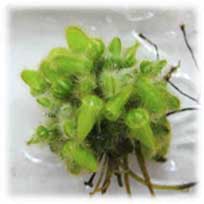RESEARCH: Evolution of carnivorous plants (4) Molecular mechanisms of plasicity in Cephalotus follicularis
Gergo Palfalvi (graduate student in SOKENDAI [The Graduate University for Advanced Studies]) with advices of Dr. Kenji Fukushima at Colorado Univ. and Assist. Prof. Yosuke Tamada.
Organisms are plastic to adapt unpredictably changing environments. The molecular bases of the plasticity have not been well studied, since most experiments have been done in culture rooms with fixed environment. We found that Cephalotus follicularis forms pitcher leaves at 25ºC and flat leaves at 15ºC and investigate what are differences between two conditions as well as other environmental changes at the genome level.

Two types of leaves inCephalotus follicularis.

Cephalotus follicularis with only flat leaves.

Cephalotus follicularis with only pitcher leaves
- Development of carnivorous pitcher leaves of Sarracenia purpurea
- Evolution of digestive enzymes
- Molecular Mechanisms of Memory of Dionaea muscipula leaves
(link to "Mechanisms and evolution of plant movement") - Molecular mechanisms of plasticity in Cephalotus follicularis
- Genome analysis of Drosera spatulata and development and evolution of tentacles, and homology between Drosera and Dionaea traps.
- Development and evolution of Nepenthes pitcher leaves

